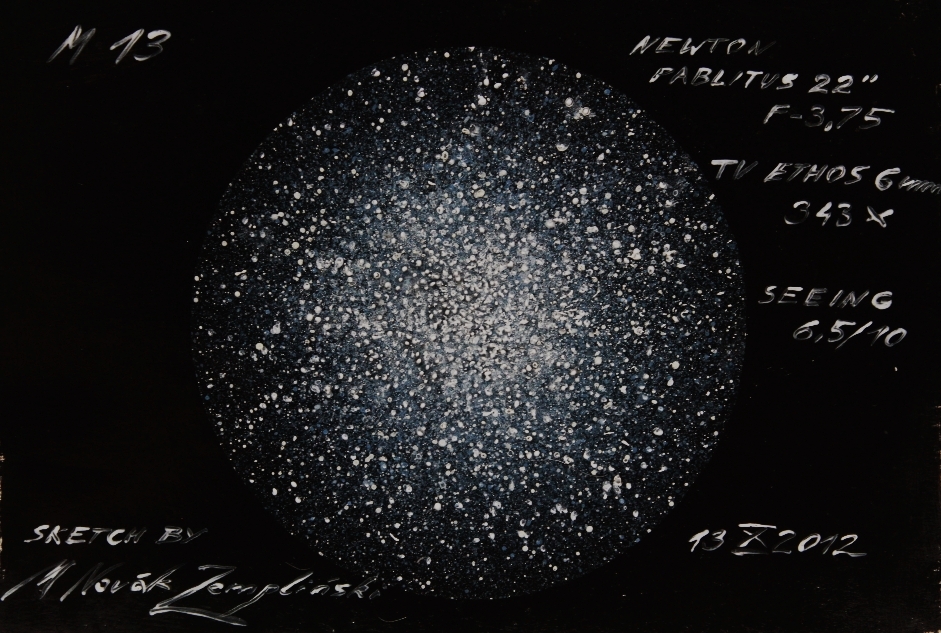
My name is Maksymilian Novak-Zemplinski and I’d like to show what I can
see throu my new baby newtonian reflector Pablitus 22″.
Best regards
MNZ
Location : Poland, near Warsaw.
Media: akrylic/oil painting on panel.
Date: 13/14 October 2012
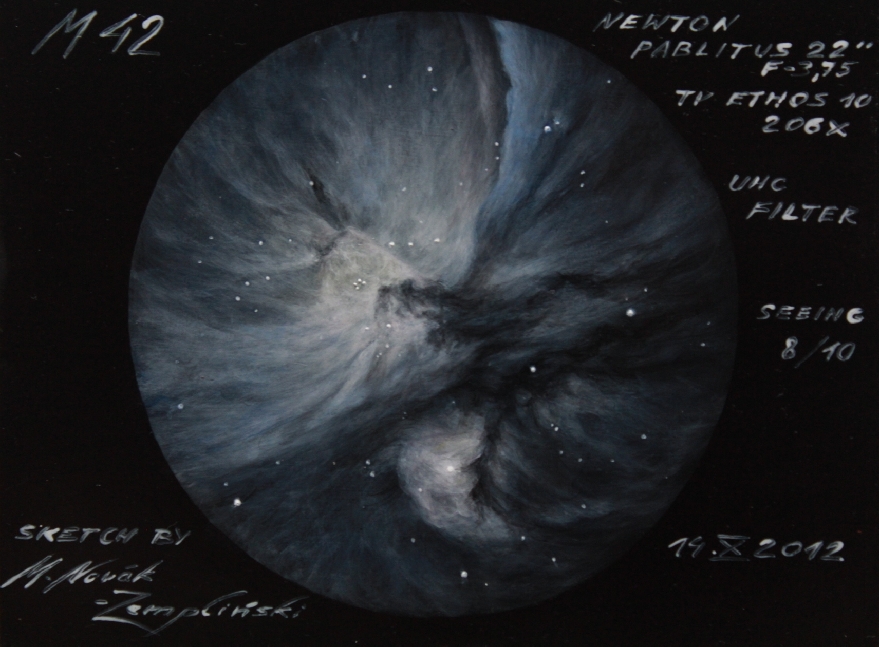
My name is Maksymilian Novak-Zemplinski and I’d like to show what I can see through my new baby Newtonian reflector Pablitus 22″.
Best regards
MNZ
Oject name: M42 The Orion Nebula
Object type: nebula
Location: Tulowice , Poland
Date: 14 October 2012
Media: Acrylic/oil on panel
Equipment: Newtonian reflector dob PABLITUS 22″ f-3,75, Tele Vue Ethos 10mm eyepiece, Astronomik UHC filter
Seeing: 8/10
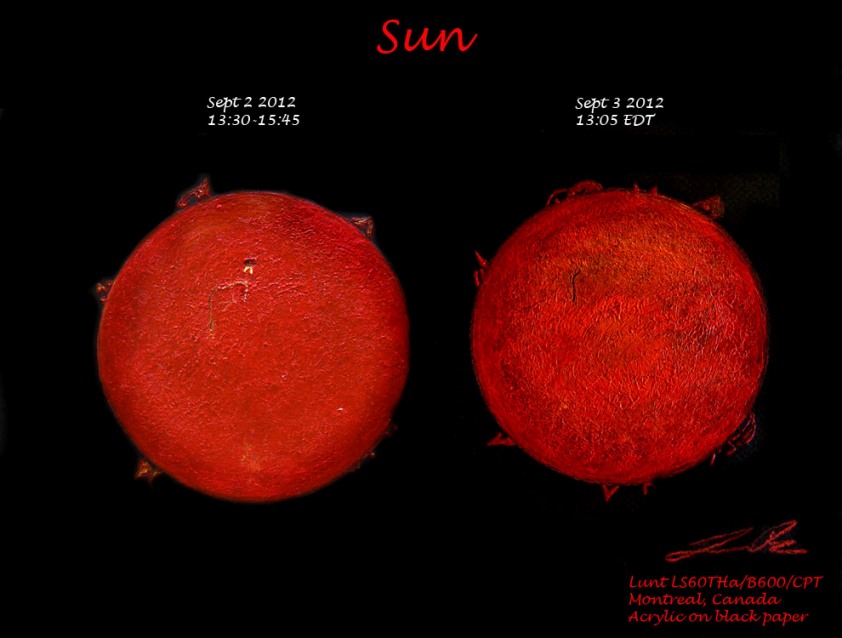
Object Name : Sun
Object Type : H alpha observation
Location : Montreal, Canada
Date : September 2 and 3
Media : Acrylic on black paper
Scope: Lunt LS60THa/B600|CPT on motorized EQ3 mount.
Our star put up a great show during 2 days. I was able to observe the «good hair day» of the sun for a total of nearly 5 hours. Many proeminences, which remained relatively stable throughout 48 hours, could be seen. The observation of September 2nd was interesting. I started the observation around 13:00 EDT keeping the magnification low (25-50X) to sketch the whole disk and the distribution of the proeminences. I kept an eye on AR 1560, which was facing earth. Around 14:00 EDT this region began to light up. Two bright flares (showed at the upper center lane of the first disk) were clearly visible and increased in brightness for the next 30 minutes. Then they faded away and by 15:00 EDT the phenomenon ended. I was glad to be able to capture this activity on my sketch.
The sketches were done on black Pastel Paper with HB pencil to record details of the proeminences. The disk was traced with a compass. Acrylic paint (red and yellow) was then used to reproduce the color seen in H alpha. The paint was layered with large and small brushes directly on the lines of the HB pencil. The two separate sketches were photographed and then assembled with Photoshop CS3. No color or contrast adjustment were done except for the background.
Jean Barbeau
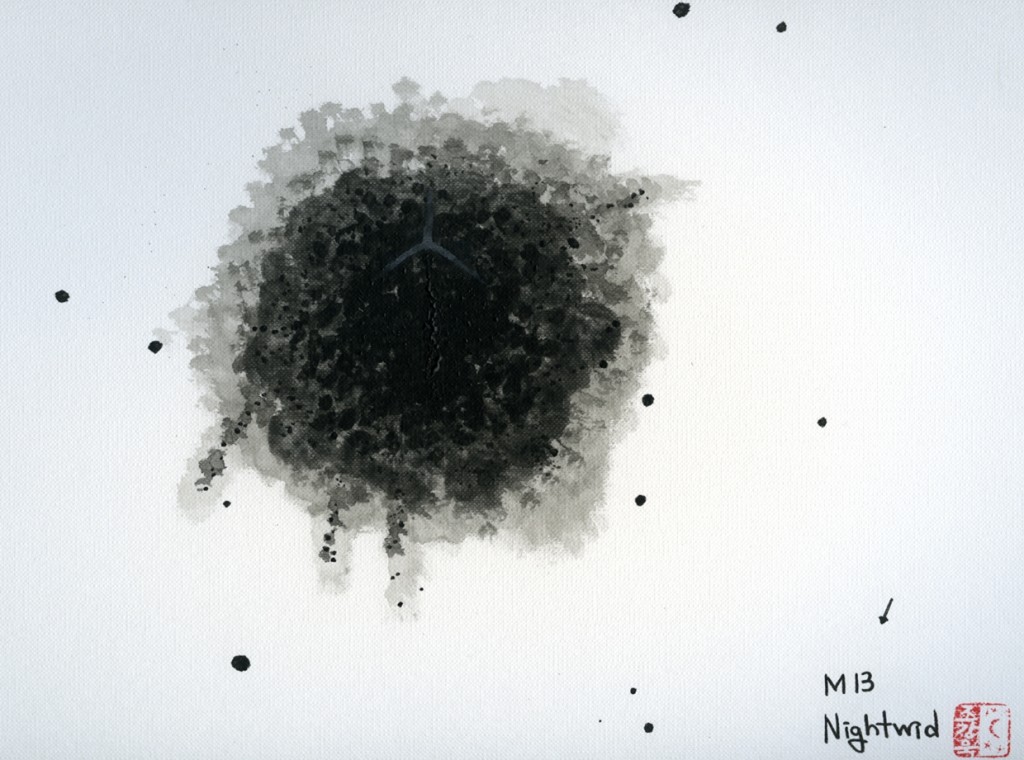
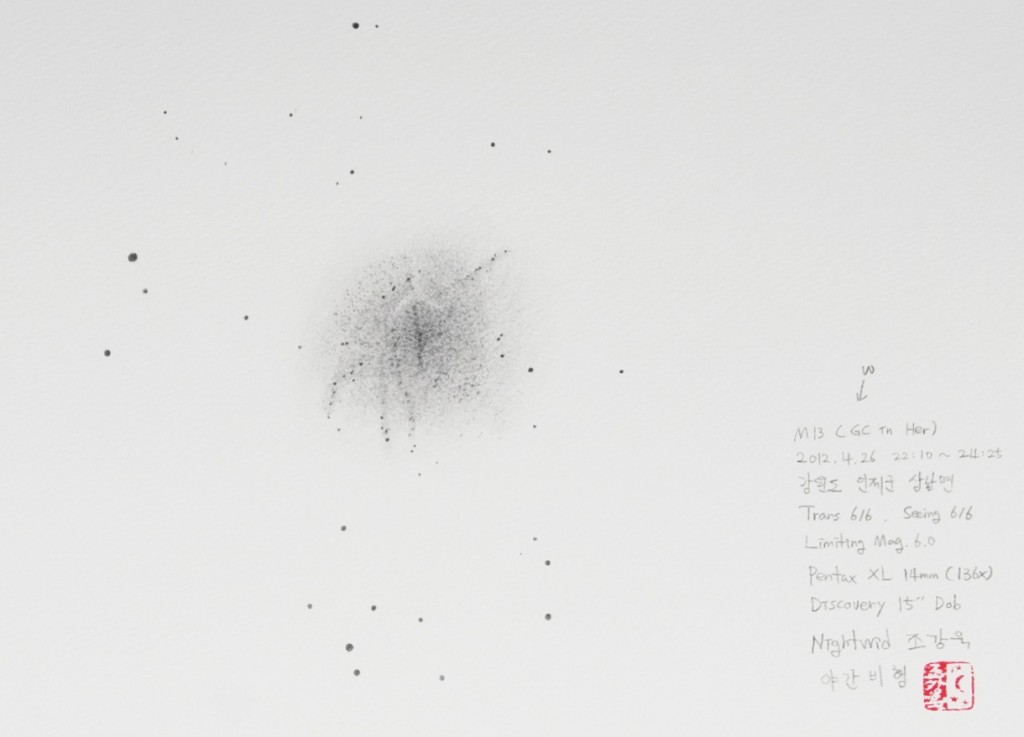
I saw the ‘Propeller’ in M13 under a good seeing condition.
Description
http://www.nightflight.or.kr/xe/files/attach/images/25489/802/057/34b6a07cb0a827ec613ab2e5188e9ee2.jpg
Equipment : Discovery 15″
Media : Sharp pencil
Location : Inje, S.Korea
After few days, I went to the national art gallery to see monochrome paintings.
Suddenly an inspiration flashed through my mind.
And I drew the M13 with acrylic & brush.
I love this tough painting than detailed sketch!
Nightwid 無雲
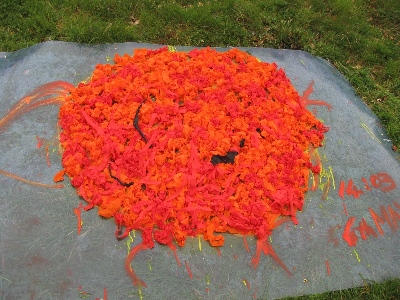
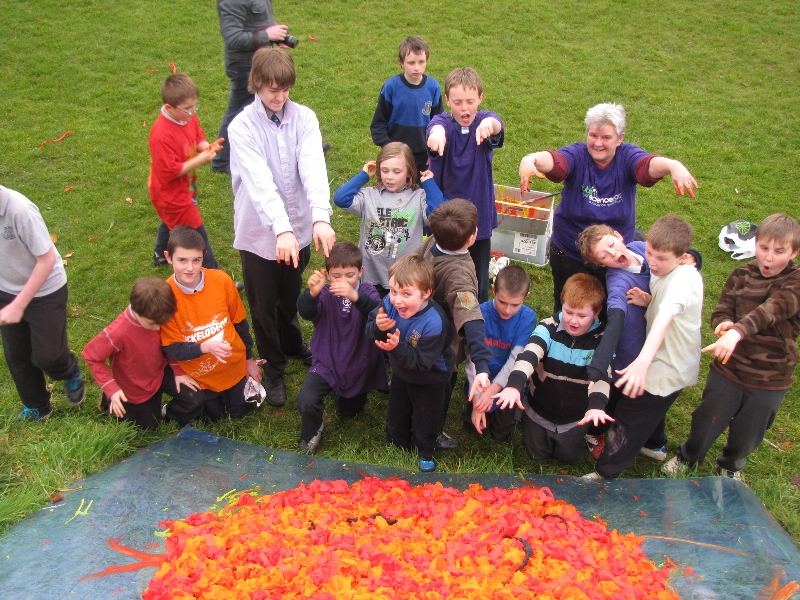
St Cronans Stargazers St Cronans National School
Bray Co Wicklow
Ireland
13:00 – 14:03 UT
May 4th 2012
May 4th 2012 14:03 UT Crepe Paper, Acrylic Paint, Washable Glue, Structure Gel and energy. Today in Bray Co Wicklow Ireland 16 boys from St Cronans National School brought the sun to Earth. Deirdre did some observations early in the day, but then because of cloud we took the rest of the information from ‘ the sun now’ on SDO. We added in Active Region 1471,with the large sunspot , some small filaments and some prominences. ( a bit of artistic licence there) We looked at the Earth to scale, we learnt about the Photosphere and the Chromosphere . We learnt about the Venus Transit. The event was part of Dublin City of Science 2012. The children did a great job and were very proud of their work. We carried our sun into the school singing ‘here comes the sun’ The Sun will be on exhibit for all the pupils to see and learn. The boys were members of St Cronans Stargazers the kids astronomy group based at the school. Action Sun – Lets bring the Sun to Earth by Deirdre Kelleghan Action Sun – is an indoor or outdoor activity which allows groups of children to participate in building a large solar disc or several solar discs. This Earth built sun mimics the Photosphere and Chromosphere of the sun, includes sunspots, filaments, and prominences present on the sun in real time. The materials are simple, paper, glue and paint. It is kinaesthetic participatory learning for young children. The activity educates and supports science through art and the creative process. We made the Sun on Earth and also learnt about the Venus Transit
Action Sun participantes were St Cronans Stargazers:
Daniel
Sean S
Ruan
Sean K
Ben
Max
Tony
Eoghan
Connor
Gerard
Ruairi
Adam
Sam
Evan
Diamuid
—
Deirdre Kelleghan
Discover Science and Engineering Science Ambassador 2012
Vice Chair IFAS
National Coordinator for Astronomers Without Borders
UNAWE rep Ireland
http://deirdrekelleghan.net
http://twitter.com/skysketcher
Pre Order Our Book on Lunar Sketching
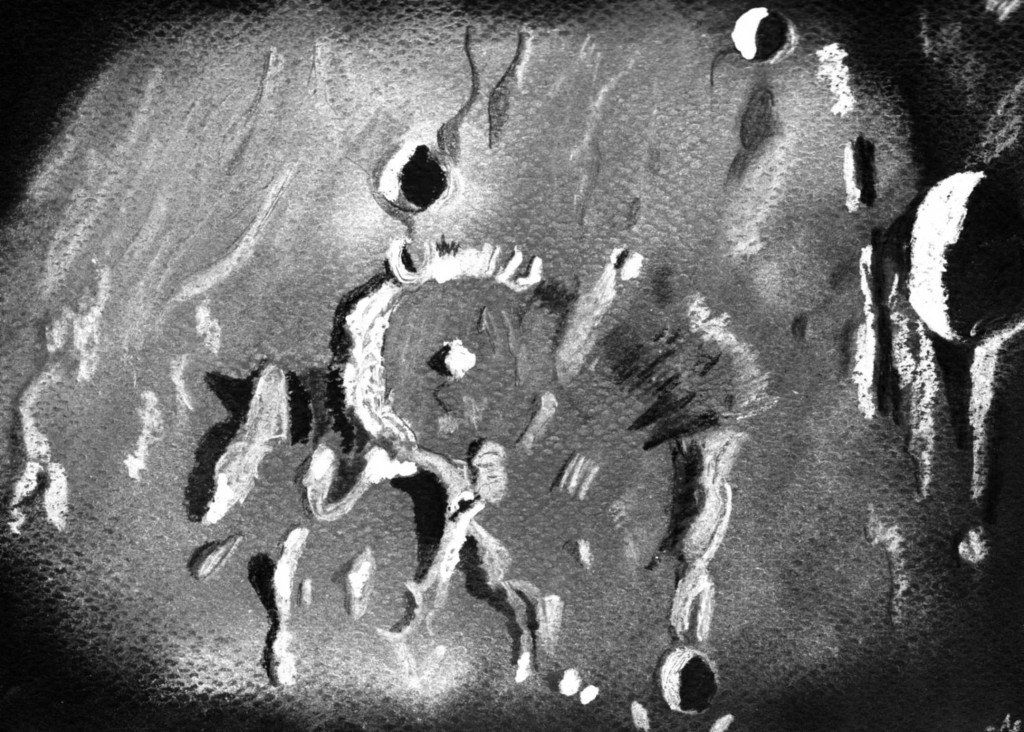
Dear Lunar fans hope this might be of interest? A study of Pallas and ruinous Murchison I made yesterday evening (January 31, 2012, 2130UT), I was using the Watec 120N+ with the 20″ mirror onto a b&w monitor, very cosy in the -3 temp outdoors, various pastels, pencils and paint were used on black heavy grained art paper.
Best, Dale
http://chippingdaleobservatory.com/blog/
Object : Moon/ Partial Lunar Eclipse
Date : June 26, 2010
Time : 04:45 LST / 11:45 UT
Location : Wickenburg Arizona USA
Instrument : Naked eye observation
Weather : Moderate winds, cool upper 70’s , clear skies and the glow of the
semi-eclipsed Moon.
Medium : Acrylic paint on canvas paper 8.5 x 11
Comments :
This was my chance, I’ve wanted to do this acrylic paint since quite a while
back! I figured since the Moon will shed some light on the subject, I might
as well take advantage of the situation. At first, I didn’t know how big to
go on the canvas since I wanted to put some detail on the eclipsed Moon. Too
big and I might just make a weekend project out of something simple. So, I
settled for an 8.5 x 11 inch, which would make it easy for me to scan and
upload without to much hassle.
I framed my view next to a Saguaro cactus and set myself so that if I
painted the foreground first, the Moon will still be in the vicinity of my
selected view within an hour or so later. Shortly after 10:00 UT, I noticed
the Moon began to creep into the Earth’s shadow but that was not the time
for me to immortalize it on canvas just yet. I didn’t know how hard this
task was going to become but I realized it was going to be trickier than I
had anticipated. After brushing away on the static vegetation for almost an
hour and keeping an eye on the Moon that kept inching closer to the horizon,
I had to act on it ‘pronto’.
The full Strawberry Moon lay there tranquil and serene but being eaten away
by the umbral darkness. I noticed the shadow working its way from Mare
Frigoris and moving down onward into part of Oceanus Procellarum, all of
Mare Imbrium and Mare Serenitatis, and a portion of Mare Tranquilitatis and
Mare Fecunditatis. At this point, I would say the Moon was about 40 percent
covered while it would still go on to cover for a total of 50 percent or so.
While this was a naked eye session, I still carried my 12 x 60’s just for
kicks. I noticed through the binoculars that the Northern part of the Moon
had a pinkish to copper hue along that edge. I thought perhaps half the Moon
would turn red orange but that wasn’t the case, I guess I’ll have to wait
until December of this year to get that effect when we get the entire lunar
eclipse! : D
Wishing you dark and clear nights!
Juanchin
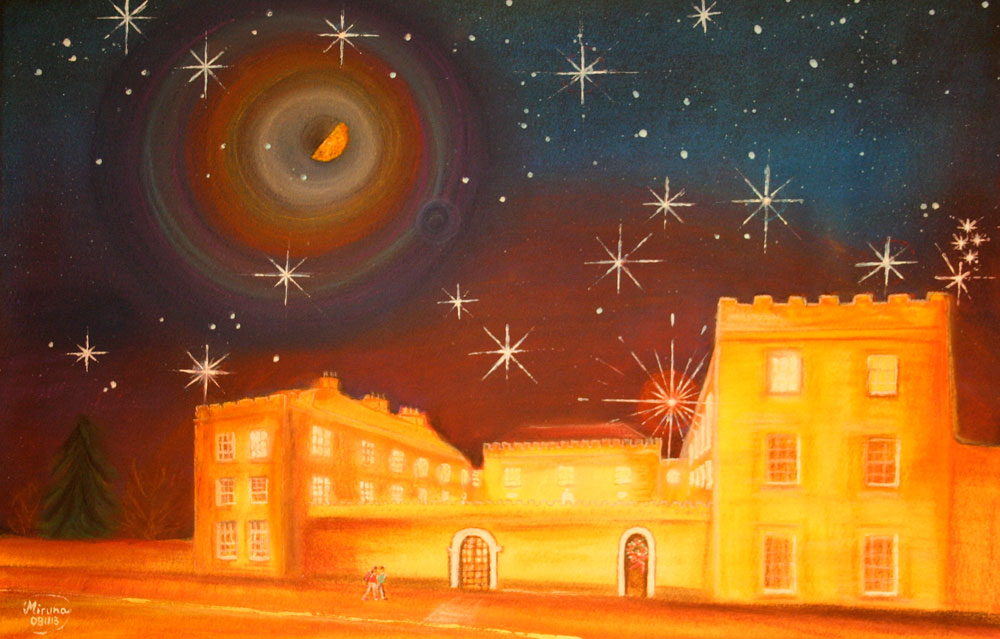
Moon over Armagh on Christmas Eve
Sketch and Details by Miruna Popescu
This painting depicts how the southern sky looks on 24 December 2009 at 5.30 pm, when the Moon’s phase reaches first quarter. The next brightest celestial object at this time is the planet Jupiter, which this year is the “Christmas Star” for the Royal School, Armagh. Jupiter is seen here just before it disappears behind the school. The painting shows stars in Pisces, Pegasus, Aquarius and other constellations, and the location of the planet Uranus (visible through a telescope) about a third of the way from the Moon to Jupiter. Uranus was found in 1781 (seven years after the old building of the Royal School was completed) by the astronomer and musician William Herschel, the discovery constituting the first identification of a planet since ancient times and earning Herschel the post of King’s astronomer from George III.
In 1609, the year after the founding of the Royal School, Galileo Galilei used an early telescope to map the Moon and discover satellites of Jupiter. To mark the 400th anniversary of Galileo’s first use of the telescope to observe the sky, 2009 is being celebrated worldwide as the International Year of Astronomy.
Dr Miruna Popescu from Armagh Observatory is the coordinator for the International Year of Astronomy 2009 in Ireland.
Eclipse
The total solar eclipse seen from the Turkish Mediterranean coast last year
was our first eclipse. It was an overwhelming and unforgettable experience.
We wanted to soak up the spectacle and so deliberately did not take a
camera, our only equipment was binoculars for a quick look at prominences
and the corona immediately after the start of totality.
All the textbook sights were there, Venus and Mercury before totality, the
pink prominences, a gauzy corona pearly white and twisted and pulled by the
sun’s magnetic fields, diamond rings whiter than diamonds and the receding
lunar shadow blotting out distant mountains. That much was expected. But the
overpowering impressions were the ones that were not expected. The point
like sun and greying light before totality like being in a steel tank lit by
a single light bulb. The rapid and wholly shocking plunge downwards in light
as totality started. The swiftly changing and blazing diamond rings, the
sheer speed of it all. For the first time we got the real sense that we were
on a turning Earth with the Moon and Sun shifting and moving in the heavens.
This little acrylic on board painting tries to sum up those impressions. It
fails miserably – but then what could succeed when pitted against a real
solar eclipse!
Les Cowley